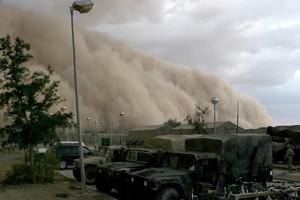Climate threatsThe costs of extreme weather
An expert tells lawmakers that there is one “underappreciated” fact in discussions about the costs of climate change: “small shifts in long-term average conditions — what we call climate — can have a large effect on the frequency of extreme weather events.” Examples: “In 2017, Hurricane Harvey caused an estimated $125 billion in losses, with an estimated 200,000 homes experiencing damage. Ongoing flooding in the upper Midwest is sure to produce agricultural losses alone in the billions of dollars, and extreme drought across much of the U.S. in 2012 caused $33 billion in losses.”

Climate change causes extreme weather like the sandstorm shown // Source: wikipedia.org
On Thursday, 16 May climatologist Radley Horton from Columbia’s Lamont-Doherty Earth Observatory testified before the Senate’s Subcommittee on Science, Oceans, Fisheries, and Weather. Senator and chairman of the subcommittee Cory Gardner (R-Colorado)., convened the hearing — titled “Atmospheric Science Research and Forecasting Innovation” — to examine the current state of atmospheric and forecast research.
Horton cited quantifiable losses already associated with extreme weather events.
“In 2017, Hurricane Harvey caused an estimated $125 billion in losses, with an estimated 200,000 homes experiencing damage. Ongoing flooding in the upper Midwest is sure to produce agricultural losses alone in the billions of dollars, and extreme drought across much of the U.S. in 2012 caused $33 billion in losses,” said Horton.
Horton, who often provides interviews and background information about climate science to media, underscored the importance of investment in science and providing science communication to decision-makers in order to realize the “great potential of risk reduction and new opportunities across the U.S. economy.” Marie DeNoia Aronsohn writes in State of the Planet that much of his prepared testimony focused on what he called the “underappreciated” fact that “small shifts in long-term average conditions — what we call climate — can have a large effect on the frequency of extreme weather events.”
The following is his full testimony.
Mr. Chairman, and Members of the Subcommittee, my name is Radley Horton. I am an Associate Research Professor at Columbia University’s Lamont-Doherty Earth Observatory. Thank you very much for the opportunity to participate in this hearing. I have served as an author on the 3rd and 4th U.S. National Climate Assessments, and as a Lead Principal Investigator within NOAA’s Regional Integrated Sciences and Assessments (RISA) Program. I speak to you today though in my personal capacity as a private citizen.
Extreme weather events, such as tropical storms, heat waves, inland flooding, and droughts, threaten the economic livelihood of our nation and the health and safety of our communities. In 2017, Hurricane Harvey caused an estimated $125 billion in losses, with an estimated 200,000 homes experiencing damage. Ongoing flooding in the Upper Midwest is sure to produce agricultural losses alone in the billions of dollars, and extreme drought across much of the U.S. in 2012 caused $33 billion in losses. In light of growing federal, state, and local costs of extreme weather events, preparedness and early warning to reduce vulnerabilities is critical. Better forecasts, and enhanced communication of scientific information with decision-makers, are necessary preconditions for increased preparedness, improved disaster response, and long-term resilience.
